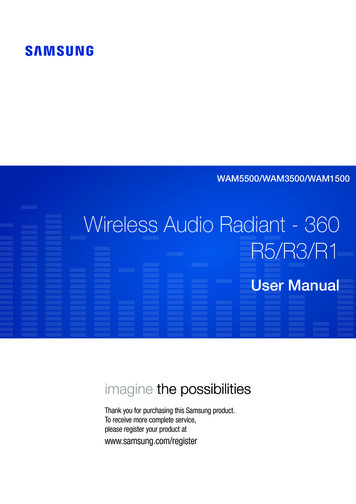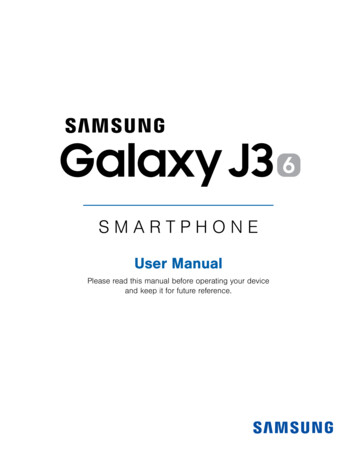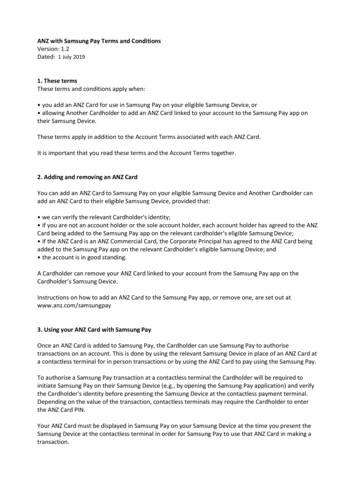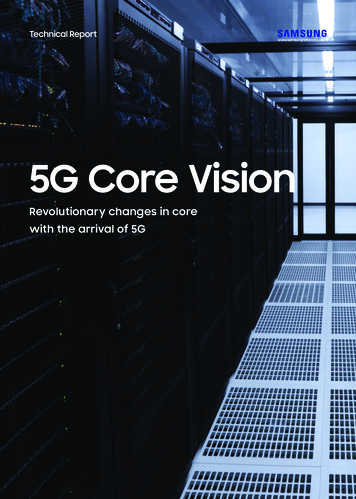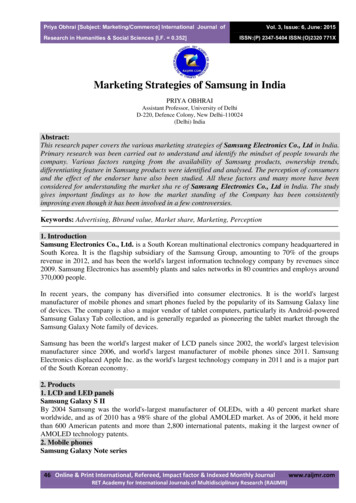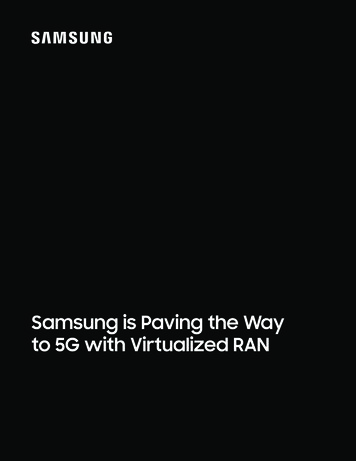
Transcription
Samsung is Paving the Wayto 5G with Virtualized RAN1
With a laser-sharp focus on reducing costs, today’s forward-looking mobile networkoperators (MNOs) are looking for ways to leverage the benefits of IT infrastructurein their networks.Technologies like Software Defined Networks(SDN) and Network Function Virtualization (NFV)in their core networks began delivering improvedoperational benefits, and now, MNOs are beginningto apply those SDN/NFV learnings in earnest to the5G Radio Access Network (RAN).Given the dominance of RAN equipment in thenetwork, some believe that virtualization anddisaggregation will optimize the component costsand equipment operations to ensure that 5Gnetworks deliver value to stakeholders. MNOsaround the world are deploying Samsung vRANequipment to gain the operational advantages ofIT-based architecture while maintaining the highgrade telco quality needed for 5G environments.This paper explores the drivers and the approachthat Samsung is taking to deliver the virtualizedRAN to leading network operators.IT Advantages of Virtualizationand Disaggregation Eliminates vendor lock-in by removingcustom hardware-based implementations Increases new function velocity with CI/CD Creates flexible network architectures tomeet any need Provides dynamic scaling anddimensioning as and when needed Optimizes resource utilization with pooling2
Samsung vRAN SolutionCharacteristicsSamsung’s vRAN solutions offer mobile operatorsa variety of network solutions that can improvethe flexibility of the network as well as reduceboth CAPEX and OPEX. Operators are exploring atransition to RAN from the “integrated cell site”which includes baseband, radio and antennacomponents as RAN offers additional flexibilityand cost saving opportunities.Field-Proven Telco Quality Implements field-proven wireless algorithms A pplies advanced techniques on x86platforms Delivers real-time processing that meetsstrict timing requirements Ensures reliability, scalability and resiliencythat provides telco-grade performanceCharacteristics that ImproveCost of OperationsMobile operators are looking for new RAN solutions to help lower their operating costs while maintainingand improving the high reliability and availability that businesses and customers expect from wiredconnections. These new 5G networks will operate in multiple spectrum ranges, allowing them toefficiently and automatically transition capacity across different spectrum for increased throughput.In addition, MNOs need to manage RANs that have a higher cell density to meet coverage and capacityneeds, as well as enable ultra-low-latency connectivity afforded by 5G. MNOs can reap significantoperational efficiencies using virtualized software-based architecture.1. Dynamic Capacity Allocation Optimizes Network Resource UtilizationSamsung’s virtualized components can automatically scale on demand to meet the needs of unexpected trafficloads, and with cloud-controlled orchestration, the centralized hardware resources can support RAN, edgeconnectivity, and back-office functions without any manual intervention. This dynamic control allows networkoperators to direct available processing resources to the software-based tasks the network currently needs.If RAN traffic patterns change, the MNO can allocate the virtualized RAN resources on the fly to meet thenew demands. During off-peak hours, operators can assign the same resources to handle operations supporttasks, like key performance indicator (KPI) analysis. This flexible scalability means that operators can buildan adaptable network that can direct capacity to any point in the system without incurring additional capitalexpenses. The ability to automatically adjust resources to meet traffic demands is a primary benefit of vRAN.2. Resource Pooling Improves Response to Traffic DemandsIn the virtualized RAN, pooling of baseband resources allows the network to use only the resourcesnecessary to meet network demand. The disaggregated nature of Samsung’s vRAN offers the abilityto assign new resources where and when needed to distribute real-time-sensitive resources nearradios while centralizing general control-related functions that can be pooled for highly efficientplatform utilization. The pooling approach enabled by disaggregation eliminates the need to purchasecapacity that may be infrequently used. Pooling offers MNOs the ability to optimize capital expenses bypurchasing only the hardware and software needed in the region, as pooled components automaticallyscale to meet the needs that exceed standard demands in the region.3
3. Link Acceleration Increases Capacity of Baseband Servers, Reducing OPEXThe RAN’s baseband functions are computationally complex and processes are intense. From channelestimation and detection to interference cancellation in MIMO, the ability to distribute these functions acrossdifferent cores increases the efficiency of baseband processing. Baseband processing includes the schedulingof these traffic flows, and the timing to complete each service is critical. Downlink (network-to-user) user datafrom the virtualized central unit (vCU) passes through a chain of processes in the virtualized distributed unit(vDU) to become physical layer packets, and all processing must complete before the start of the designatedtimeslot for that packet. On the uplink (user-to-network), the vDU must transform the received signals into theappropriate bit stream, demodulate and decode the channel, and acknowledge receipt to the device within agiven time budget. Samsung leverages Intel’s Advanced Vector Extension (AVX) instruction set to completemany of these signal processing functions efficiently. To further increase the capacity in the vDU, Samsungopts to offload CPU-intensive tasks with repetitive structures, like forward error correction (FEC) and lowdensity parity check (LDPC), to hardware accelerators on commercial-off-the-shelf (COTS) servers. With higherprocessing capacity in the vDU, MNOs can support more traffic on fewer vDUs, resulting in lower expenses.4. Automation Brings Operational EfficienciesAutomation is another technology that Samsung designed into their RAN components. In the virtualizedsolution, the cloud-controlled system can monitor specific KPIs, and when appropriate, can automaticallyallocate resources to bring operations back within network tolerances without human intervention. Thisautomation reduces the hundreds of hours of human effort spent tracking, analyzing, and managingthe cells. And with MNOs using more radios and more spectrum, the need to control equipment thathas different operational abilities across multiple spectrum bands makes automation a fundamentalrequirement. Not only does automation minimize the possibility of human errors, it also reduces thehuman-capital costs of managing a mobile network.4
Solving the Challenge of Handover in 5GMaintaining mobile connectivity as the user transitions between cells is one of the most challenging tasksfor the RAN, and operators want to minimize handovers. However, 5G can operate in very high frequencies,commonly referred to as millimeter wave spectrum, and while these frequency bands provide high throughput,they do so at the expense of coverage. For efficient 5G operations in these higher bands, the MNO will likelydeploy many cells for more frequent handovers for mobile users.At the same time, higher frequency bands also allow the use of broader bandwidth carriers, so gNBs need tohandle considerably more traffic processing capacity compared to previous base stations. Dual Connectivity,which is widely used in current 5G networks, increases the system’s capacity needs, as devices may send andreceive traffic from two different base stations. Instead of inefficiently processing the load on a distributed unit(DU), the centralized unit is a better option, as it is a more accessible site where resource pooling and sharingcan better handle the task. For these reasons, 5G deployments are best served by a separated centralized unit(CU) that is more centrally located from the DU.Samsung offers a flexible vRAN architecture that utilizes a CU, DU, and a radio, based on 3GPP compliantinterfaces as depicted in the diagram DCPPDCPvDURURLCPHY-LMACRFVirtualized unitsCompliant InterfacesPHY-HeCPRI3GPP F15
Samsung’s Virtualized ArchitectureSamsung’s new access system architecture solves these issues with a disaggregated RAN design that complieswith 3GPP-defined baseband split option 7-2, including contributions from the O-RAN Alliance known asOption 7-2x between the Radio and the vDU. Likewise, Samsung uses a standards-defined F1 interface betweenthe vDU and the centralized vCU. The new software-based architecture breaks the current baseband functionsinto tasks that optimize 5G RAN service operations, which also automatically scale resources when needed.Site ARUvDU1vCUSite BRUvDU2vDU3Site CRUvDU1vDU2vDU4 vDU5vDU3CoreSite DRUvDU4Site ERUvDU5Disaggregated vRANOption 7-2xRadios:From the air-interface side of the RAN, Samsung’s Radios communicate with the user equipment (UE)operating within the coverage area of that radio. The Radio supports RF functions, which instruct the antennaon how to communicate with the UE in its field. The Radio also supports the real time-sensitive Low-Phycomponent of the radio stack, which contains applications like Fast Fourier Transformation (FFT) signalprocessing and resource element mapping. The Radio uses enhanced Common Public Radio Interface (eCPRI)to support higher traffic loads than prior protocols between the radio and controller.Distributed Unit:The Samsung vDU is a containerized implementation of the real-time sensitive baseband functions. ThevDU provides the modulation and layer mapping of signals for user-bound traffic. For network-bound traffic,it performs the channel estimation and equalization and maps the received frequencies back into the timedomain for transport to the application.6
Centralized Unit:The Samsung vCU is a virtual machine (VM) based implementation of the non-real-time centralized basebandfunctions. The vCU allows pooled resources to scale on-demand at the direction of the orchestrator in supportof capacity on each connected DU. For example, the figure above represents four vCUs supporting five sites,where one of the vCUs controls two remote DUs. The standard defined F1 interface on the Samsung vCUsupports control and user plane separation (CUPS). These virtualized capabilities offer proven stability andperformance based on deployments in Korea and North America.5G vRAN Ecosystem:Samsung and the entire ecosystem continue innovating new capabilities to improve vRAN technologiesfor MNOs. This ecosystem allows for the creation of products from organizations with expertise in specificdomains, enabling faster time to market for high-tech solutions. By collaborating with leading-class suppliers,Samsung leverages those functional experts to incorporate best-in-class products to offer vRAN solutions thatmeet customer demands.Samsung’s vRAN Architecture Delivers for 5GSamsung is providing mobile network operators with solutions that use virtualization in many parts oftheir network today to help enable cost efficiencies. In 2017, Samsung started working with operatorsaround the world to develop and operate the flexible and future-proof virtualized RAN. Network operatorsdeploying virtualized cells in 4G LTE networks are seeing the cost savings of centralized RAN, and theybelieve that further virtualization can bring more benefits. These 4G sites can coexist with 5G and requireonly a software upgrade to transition to 5G vRAN. Samsung firmly believes this future-proof virtualized RANsolution with open, standards-compliant interfaces, will form the cornerstone for global 5G innovation, as itwill offer network operators the flexibility and adaptability to develop and deliver new, innovative services.7
6625 Excellence DrPlano, TX 75023Sales: 1.877.556.9469Service & Support: 1.800.737.7008samsungnetworks.com
Samsung’s vRAN Architecture Delivers for 5G Samsung is providing mobile network operators with solutions that use virtualization in many parts of their network today to help enable cost efficiencies. In 2017, Samsung started working with operators around the world to develop and operate the flexible and future-proof virtualized RAN.


